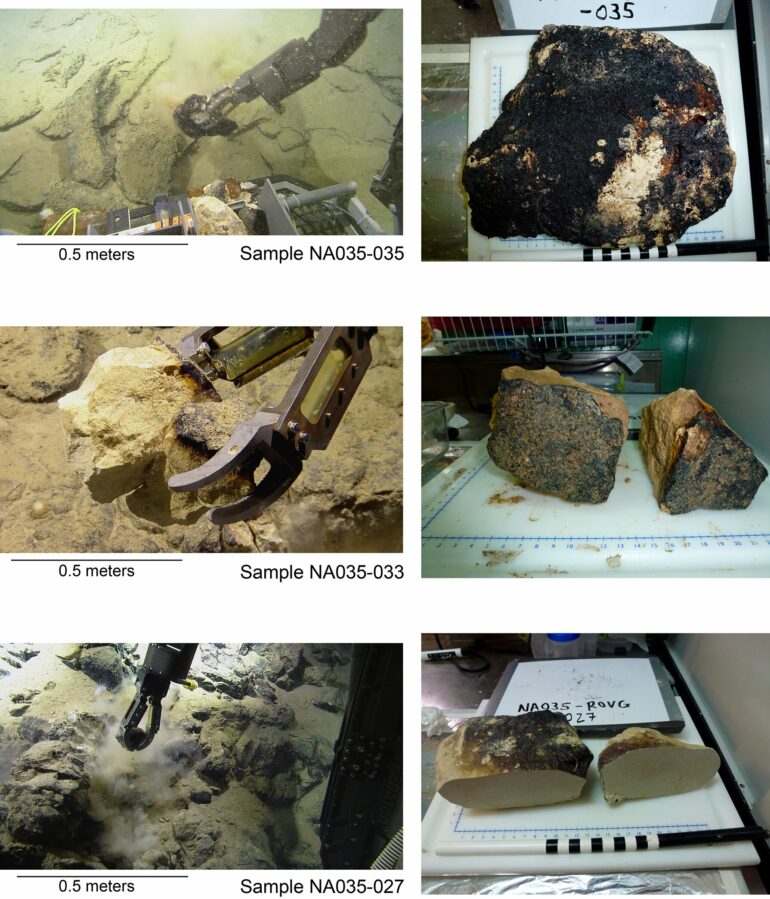Marine and coastal geoscience play a critical role in understanding ancient and modern geological history, offshore and coastal hazards, and climate change. Deep-water environments prevent scientists from directly visiting field sites, so unique methods must be employed for researching the ocean floor.
One common approach is offshore drilling, which provides core samples that can be analyzed in laboratories. While this method is useful for retrieving otherwise inaccessible materials, it is expensive and has its limitations.
A study in Geosphere explores a more cost-effective alternative: deploying a remotely operated vehicle (ROV) to record exposed rock layers on the ocean floor and construct virtual outcrops.
Constructing a virtual outcrop is essential for reconstructing a region’s ancient history and understanding the geological processes and hazards that have shaped it. ROVs can also collect rock samples from various locations on the ocean floor, which allows scientists to deepen their analysis through visual rock identification and laboratory examination.
While ROVs cannot retrieve samples from the subsurface like ocean drilling can, this more cost-effective method can retrieve samples from the ocean floor and video record seafloor morphology, which cannot be done with ocean drilling.
The data collected via ROV exploration is both highly valuable and more accessible to a wider range of scientists.
The Mona Rift’s seismic hazards
The Mona Rift, located northwest of Puerto Rico, is a seismically active area that presents real hazards to Puerto Rico’s coastal communities. One of the most devastating seismic events in the region was the 1918 tsunami. Triggered by a magnitude 7.2 earthquake, this event caused an underwater landslide, leading to widespread flooding in Puerto Rican coastal towns.
Despite the risks, data on the Mona Rift remains limited due to a lack of previous drilling expeditions, making it an ideal location for ROV-based research. Investigating this region’s geology can help scientists better understand local geologic hazards and prepare for future natural disasters. For example, analyzing the geologic history can uncover a more detailed record of past earthquakes preserved in the rocks.
This knowledge allows scientists to make more informed assessments about current earthquake-related hazards, including the magnitude and frequency of potential future events.
Such valuable insights are crucial for protecting communities at risk of earthquake-related hazards.
Virtual outcrop methodology
A team led by Dr. Uri S. ten Brink, a geoscientist with the U.S. Geological Survey, deployed an ROV at water depths ranging from approximately 5,000 to 13,000 feet to study the region.
Using a combination of video frames and seven ROV-collected rock samples, the team determined the age and geologic history of the Mona Rift. Dr. ten Brink compared the video data collected by the ROV to footage “from a passing car along an outcrop on land.” He emphasized that this method allows scientists to “extract so much more from existing data than was previously assumed.”
Discover the latest in science, tech, and space with over 100,000 subscribers who rely on Phys.org for daily insights.
Sign up for our free newsletter and get updates on breakthroughs,
innovations, and research that matter—daily or weekly.
New insights
Although there are correlations between offshore and onshore rock formations, ten Brink’s research revealed discrepancies between the two environments. The team identified a 330-foot gap in the geologic record between the onshore and offshore formations, along with variations in rock thicknesses that suggest distinct geological evolutions.
Their stratigraphic analysis indicates that the Mona Rift is approximately 3.3 million years old, making it roughly 30 million years younger than some of the surrounding rock formations. According to Dr. ten Brink, this suggests that the Mona Rift “is young” and that tectonic rifting is “occurring at a higher rate than previously assumed.”
Seismic risk and coastal communities
By combining offshore data collected by the ROV with existing onshore data, ten Brink and his team developed a more comprehensive geological history of the region. The ROV’s ability to gather both visual and physical data provides unique insights into the geologic record, demonstrating its potential for cost-effective research in remote, deep-water environments.
This approach not only advances our understanding of ancient geological events but also has practical applications for evaluating and mitigating future risks to coastal communities.
The findings of this research are particularly valuable for understanding the geological processes that have contributed to destructive hazards in Puerto Rico’s past—and for identifying risks that could emerge in the future. Employing ROVs for offshore stratigraphic and geological analysis has provided a fresh perspective on the geology and geologic hazards of offshore Puerto Rico.
More information:
Uri S. ten Brink et al, Field geology under the sea with a remotely operated vehicle: Mona Rift, Puerto Rico, Geosphere (2024). DOI: 10.1130/GES02762.1
Provided by
Geological Society of America
Citation:
Remotely operated vehicles provide new insights into Mona Rift’s seismic risks (2025, January 8)



